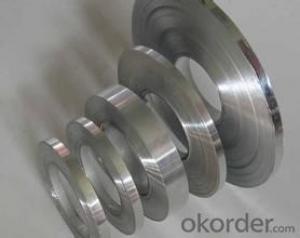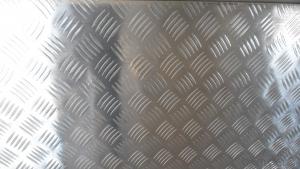Weight of Aluminum Sheets - Aluminum Strip 1060 for Transformers or Electronics
- Loading Port:
- Shanghai
- Payment Terms:
- TT OR LC
- Min Order Qty:
- 5 m.t.
- Supply Capability:
- 9000 m.t./month
OKorder Service Pledge
Quality Product, Order Online Tracking, Timely Delivery
OKorder Financial Service
Credit Rating, Credit Services, Credit Purchasing
You Might Also Like
Specification
Grade:
1000 Series,3000 Series,4000 Series,5000 Series,6000 Series,7000 Series,2000 Series
Surface Treatment:
Coated,Embossed,Anodized,Polished,Mill Finish,Color Coated,Oxidized,Enameled Wire,Brushed,Printed,Composited,Holographic Impression,Sand Blasted,Powder Coating
Shape:
Angle,Square,T-Profile,Round,Flat,Rectangular,Oval,Hexagonal
Temper:
T3-T8,O-H112,T351-T651,T351-T851,Soft,Half Hard,Hard
Application:
Liner & Wad,Decorations,Door & Window,Heat Sink,Transportation Tools,Glass Wall,Food,Kitchen Use,Pharmaceutical,Seal & Closure,Insulation Material,Label & Tag
3003/1100 aluminum strip
| Product name | alloy | temper | thickness(mm) | width(mm) | Inner Diameter | Application | Processing way |
| aluminum strip | 1070 1060 1050 1145 1235 1100 1200 3003 8011 | H18 H26 H14 H24 H22 O | 0.2mm~3.0mm | 10mm~300mm | 75mm,150mm,300mm,505mm | All kinds of industry aplicaiton | DC or CC |

Product | Aluminum Strip/Tape |
| Alloy | 1050, 1060, 1070,1080,1085,1100, 1200,1145 3003, 3004,3005, 3102,3103,3104,3105, 3A21 5052,5052A,5657, 5754,5082,5083,8006,8011 |
| Temper | O, H12, H14, H16,H18 H22,H24,H26,H28,H32,H34,H36,H38 |
| Thickness | 0.06mm-5.0mm(Or Customer's requirement) |
| Width | 10mm-600mm |
| Lead Time | Within 20 days after receiving deposit |
| Packing | Standard Exporting wooden pallets |
| Surface: | Bright & Smooth Surface, Free from defects like white Rust, Oil Patch, Edge Damage. |
| Application | PP cap stock, hot rolled thick plate, aluminum curtain wall base plate, the traffic sign ,air-conditioner heat and exchangers, food container, household foil,Transformer,Shutter,Blind,Air Conditioning |
Packaging & Delivery
| Packaging Details: | Strong seaworthy packing, wooden case or pallet. One wooden pallets is about 1.0Tons to 2.0Tons/pallets. One 20GP container can load about 20Tons of aluminium strps. |
| Delivery Detail: | 15 days to 20 days after 30% TT depoist or the copy of LC |

- Q: This question asks for the cost of an aluminum sheet.
- <p>The cost of aluminum sheets can vary significantly based on factors such as thickness, grade, surface finish, and market conditions. As of my last update, the price range for aluminum sheets could be anywhere from $0.50 to $5 per pound, but this is subject to change. For the most accurate and current pricing, it's best to check with suppliers or on metal exchange platforms, as prices can fluctuate daily. Always consider the specific requirements of your project to determine the exact type and grade of aluminum needed, which will also affect the cost.</p>
- Q: Can 101 aluminum sheets be bent or formed into different shapes?
- Certainly! It is indeed possible to bend or shape 101 aluminum sheets into various forms. Aluminum possesses high malleability, meaning it can be shaped effortlessly without any risk of breaking or cracking. The specific grade of aluminum, such as 101, signifies the alloy composition and might possess specific properties that make it more suitable for bending and shaping. Nevertheless, the capacity to bend or shape aluminum sheets also relies on their thickness; thicker sheets may necessitate greater force and specialized equipment. In conclusion, with the correct tools and techniques, it is feasible to bend or shape 101 aluminum sheets into diverse shapes to fulfill specific requirements.
- Q: how many protons,nuetrons, and electrons are in aluminum?
- Aluminum is element 13, so it has 13 protons. This also means that it normally has 13 electrons (provided it is not in an ionic state). Normally it has 14 neutrons, but may have less or more in various isotopes.
- Q: Is it feasible to recycle aluminum profiles after their use?
- <p>Yes, aluminum profiles can be easily recycled after use. Aluminum is one of the most recycled materials in the world due to its durability and recyclability. Recycling aluminum saves energy, as it requires only 5% of the energy needed to produce new aluminum from raw materials. The recycling process is straightforward, involving melting the aluminum, which can then be reformed into new products without losing its properties. This makes aluminum profiles an environmentally friendly choice for many applications.</p>
- Q: Can aluminum sheet be used for electrical wiring?
- No, aluminum sheet cannot be used for electrical wiring.
- Q: Can 101 aluminum sheets be purchased in small quantities or only in bulk?
- Aluminum sheets can typically be purchased in both small quantities and bulk, depending on the supplier and their policies. It is advisable to check with the specific supplier to determine the availability of purchasing 101 aluminum sheets in small quantities.
- Q: Can aluminum sheets be used in automotive applications?
- Aluminum sheets find their utility in automotive applications. This lightweight and sturdy material brings a multitude of advantages to the manufacturing of automobiles. It is widely employed in the creation of car bodies, hoods, doors, roofs, and various other components. By incorporating aluminum sheets into automotive applications, the overall weight of the vehicle can be reduced, thereby enhancing both fuel efficiency and performance. Moreover, aluminum boasts exceptional resistance to corrosion, making it well-suited for enduring harsh weather conditions and exposure to road salt. Additionally, aluminum can be easily molded and shaped, facilitating intricate designs and detailing on automotive parts. In summary, the utilization of aluminum sheets in automotive applications contributes to the creation of vehicles that are lighter, more fuel-efficient, and visually appealing.
- Q: Can aluminum sheet be used for aircraft skin panels?
- Certainly, aircraft skin panels can indeed be made from aluminum sheet. As a matter of fact, aluminum is extensively employed as the preferred material for constructing such panels owing to its highly advantageous properties. Aluminum possesses the qualities of being lightweight, robust, and resistant to corrosion, rendering it an ideal selection for aircraft production. Moreover, aluminum is effortlessly malleable, facilitating the shaping of the panels into the precise contours and curves necessary for aircraft design. Furthermore, it exhibits commendable heat conductivity, aiding in the dissipation of heat generated during flight. All in all, aluminum sheet is an exceptionally reliable and efficient material for the fabrication of aircraft skin panels.
- Q: Are aluminum sheets resistant to corrosion?
- Yes, aluminum sheets are highly resistant to corrosion. Aluminum forms a protective oxide layer on its surface when exposed to air, which prevents further corrosion from occurring. This oxide layer acts as a barrier, protecting the underlying metal from environmental factors such as moisture and corrosive chemicals. Additionally, aluminum has a low tendency to rust, making it a popular choice for various applications where corrosion resistance is crucial, such as in the construction of aircraft, automobiles, and marine vessels. Overall, aluminum sheets are known for their exceptional resistance to corrosion, which contributes to their durability and longevity.
- Q: How to solve the loose bonding of aluminum sheet and silica gel?
- Bonding silicone rubber needs surface treatment, after using silicone rubber surface treating agent of Kuer , you can bond them with 4211 adhesive.
Send your message to us
Weight of Aluminum Sheets - Aluminum Strip 1060 for Transformers or Electronics
- Loading Port:
- Shanghai
- Payment Terms:
- TT OR LC
- Min Order Qty:
- 5 m.t.
- Supply Capability:
- 9000 m.t./month
OKorder Service Pledge
Quality Product, Order Online Tracking, Timely Delivery
OKorder Financial Service
Credit Rating, Credit Services, Credit Purchasing
Similar products
Hot products
Hot Searches
Related keywords





























